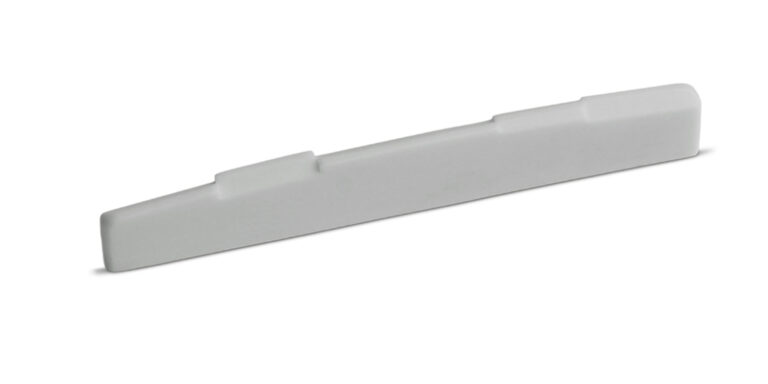Guide to Fully Compensated Guitar Saddles
You will commonly hear the term “fully compensated saddle,” but what does this refer to? There are two different ways this term is used, which can lead to confusion. First, the term is used to describe a specific saddle style type, which is often also called “step compensated” because the saddle has clearly defined compensation steps for different strings. Second, the term is used to describe a saddle that, in addition to the B compensation, has compensation for at least one other string. Let’s review each type.
Step Compensated Saddle
A step compensated saddle has clearly defined steps for different strings as in the below images, which show saddles with a 12 and 16 inch radius, respectively.


The above are the most common type of step compensated saddle. With this saddle type, there are five distinct steps – one for the treble E, one for the B, one for both the G and D, one for the A, and one for the bass E. Below is a top down view, with the bridge saddle slot angle at three degrees. The blue line shows approximately where each string would sit on the saddle’s top.

In this compensation pattern the treble E, G, and D strings sit forward, while the A sits center, and the B and bass E strings sit backward. Note that you may see other saddles with clearly defined steps, but place the strings in different spots.
B Compensated with Additional Compensation for at Least One Other String
Another use for the term “fully compensated saddle” is to describe a saddle that not only has compensation for the B string, but also for at least one other string. However, there are numerous different compensation patterns that do this. For example, consider the B compensated with slanted bass saddle shown in the below image.

With this saddle pattern, the treble E and B strings are compensated with distinct steps similar to a forward line B compensated saddle’s. However, there’s also a progressive backward slant for the wound strings. Please see our Guide to B Compensated Saddles for more information.
There are numerous other compensation patterns that compensate for the B along with at least one other string as well. For example, Martin’s wave compensated saddle puts both the B and bass E backward, but puts the treble E center, and the G, D, A strings forward. Please see the below image along with our Guide to Wave Compensated Saddles for more information.

Which Saddle Does Your Guitar Need?
Still wondering which saddle size your guitar requires? Please contact us with all of the below information.
- Guitar Year, Series, Model
- Current Saddle Length, Maximum Height, Thickness – Must be measured with a caliper
- Bass to Treble Edge Height Difference
- Bridge Saddle Slot Length and Thickness (if different from saddle specs) – Must be meausured with a caliper
- String Spacing at the Bridge
- Current Saddle Compensation Pattern (Please send a picture if you are not sure which type you have)
We will respond within 48 hours.
